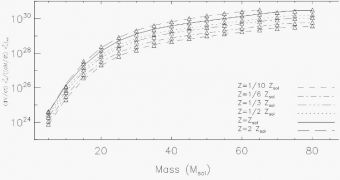Astronomers have been observing cosmic structures known as stellar nurseries for a very long time, trying to figure out the intricate processes that lead to stellar formation. The basic mechanisms are already being exposed, although more subtle factors remain to be discovered.
The first and most important thing astronomers agree upon in their studies of stellar nurseries is that the quantity and density of molecular hydrogen gas in such a cosmic formation is the key to efficient stellar production. Another, maybe equally-important aspect, is the presence of turbulences.
Whenever turbulences occur inside massive H2 clouds, the material is stirred up to such an extent that it begins to clump together under its own gravitational pull. As a threshold mass is reached, the forces pulling matter outwards, away from the cloud, are overrun by gravity.
When this happens, the cloud begins to fall in on itself, or implode. Large amounts of friction occur, generating heat that continuously accumulates as the collapse accelerates. At one point, the temperatures and pressures become high enough to start nuclear fusion between hydrogen molecules.
In effect, this is a simple explanation of how protostars come to be. After the cloud collapse is complete, whether or not a protostar will develop into a fully-fledged star, or will transform into a brown dwarf, is a matter of chance and mass. This link is called the Kennicutt-Schmidt Law.
In more recent times, astronomers have also began shedding light on other aspects controlling or regulating stellar formation rates, such as for example the factor of metallicity. Metals produced by other stellar explosions can promote the formation of molecular hydrogen from unbound gas.
As such, metal-rich stellar nurseries tend to produce stars at a more accelerated pace than their low-metallicity counterparts. However, these formations also tend to shunt the growth of their newest stars faster, a phenomenon that is caused by metallicity as well.
After stars are formed, they begin releasing solar winds, massive clouds of radiations and elementary particles. These outflows easily disperse the molecular hydrogen gas that is feeding the stars themselves, essentially prohibiting them from getting any larger.
Whenever the energy of the wind equals that of gravity, the stellar growth process stops. Certain types of massive stars are known for cleaning their neighborhoods of all traces of gas, preventing other stars from being born.
Astronomers will continue to analyze the complex interactions forming in stellar nurseries, in hope that they would someday be able to understand the way the Universe formed in more detail, Universe Today reports.

 14 DAY TRIAL //
14 DAY TRIAL //